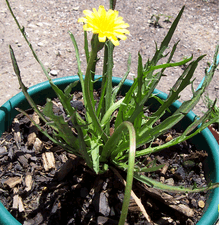Microseris lanceolata
| Microseris lanceolata | |
|---|---|
 | |
| Scientific classification | |
| Kingdom: | Plantae |
| (unranked): | Angiosperms |
| (unranked): | Eudicots |
| (unranked): | Asterids |
| Order: | Asterales |
| Family: | Asteraceae |
| Subfamily: | Cichorioideae |
| Tribe: | Cichorieae |
| Genus: | Microseris |
| Species: | M. lanceolata |
| Binomial name | |
| Microseris lanceolata (Walp.) Sch.Bip. | |
| Synonyms[1] | |
| |
Microseris lanceolata is a perennial herb also known as murnong and yam daisy.[2]
It is found in many forms in southern and eastern Australia (Victoria, NSW, ACT, SA, WA and on the island of Tasmania),[2] the Tasmanian form being markedly smaller than the mainland Australian form. A related species occurs in New Zealand, Microseris scapigera, recognised now as the correct name for plants there. In Australia that name was used earlier.
Biological descriptions
A variable species, it has the form of a tufted rosette of toothed lanceolate leaves.
The flower stalk is notable for its curious behaviour: pendulous before flowering, it becomes erect for flowering, lifting the flower to the attention of pollinators, then becomes pendulous again until the seed head ripens, at which time it becomes erect again, exposing the seed head to the best possible wind exposure. The 'flower' is a yellow head of florets, reminiscent of a dandelion. The seed heads ripen to a cluster of fluffy, tan achenes, each having a crown of fine extensions called a pappus. Seed dispersal is by wind.
Cultivation and uses
The species has edible tuberous roots and was once a vitally important source of food for peoples of Australia. Indigenous communities, particularly in the south-eastern parts of Australia, utilised advanced soil cultivation techniques to reduce erosion and improve crop yields.[3] The introduction of cattle, sheep and goats by immigrating early–colonialist Europeans led to the near extinction of Murnong {{Citation needed [4]|date=February 2017}}, with calamitous results for first Australians’ communities who depended upon Murnong for a large part of their food. Murnong was prepared by roasting or pit baking; the taste is described as "sweet with a flavour of coconut".
Gallery
 Murnong clock
Murnong clock Murnong seed comparison; Tasmanian form on left, Australian main land form on right
Murnong seed comparison; Tasmanian form on left, Australian main land form on right
References
- ↑ The Plant List: A Working List of All Plant Species, retrieved 1 July 2016
- 1 2 "Microseris lanceolata (Walp.) Sch.Bip.". Australian Plant Name Index (APNI), IBIS database. Centre for Plant Biodiversity Research, Australian Government. Retrieved 4 Mar 2013.
- ↑ Pascoe, Bruce (2014). Dark Emu, Black Seeds: Agriculture or Accident?. Magabala Books. pp. 22–24. ISBN 978-1-922142-43-6.
- ↑ Flora of Victoria, Volume 4, page 702
- Cribb, A.B. & J.W. (1974), Wild Food in Australia, pgs 150-15
- Gott, Beth (1982). "Ecology of Root Use by the Aborigines of Southern Australia". Archaeology in Oceania. 17 (1): 59–67. JSTOR 40386580. doi:10.1002/j.1834-4453.1982.tb00039.x.
- Frankel, D. (June 1982). "An account of Aboriginal use of the yam daisy". The Artefact. 7 (1–2): 43–5.
- Gott, Beth (1983). "Murnong - Microseris scapigera: A study of a staple food of Victorian Aborigines". Australian Aboriginal Studies. 2: 2–17.
- Gott, Beth (1987). "Murnong — a Victorian staple food: some nutritional implications.". In Graeme K. Ward (ed). Archaeology at ANZAAS. The 54th Congress of the Australian and New Zealand Association for the Advancement of Science, May 1984, Section 25A: Archaeology. Canberra: Canberra Archaeological Society. pp. 111–114. ISBN 978-0-9588625-0-9.
- Incoll, L. D.; Bonnett, G. D.; Gott, Beth (1989). "Fructans in the underground storage organs of some Australian plants used for food by Aborigines". Journal of Plant Physiology. 134 (2): 196–202. doi:10.1016/s0176-1617(89)80055-0. (Congress: International symposium on fructan. 1 1988)
- Gott, Beth; Conran, John (1991). Victorian Koorie plants : some plants used by Victorian Koories for food, fibre, medicines and implements. Hamilton and Western District Museum. Yangennanock Women's Group, Aboriginal Keeping Place. ISBN 0-646-03846-X.
- Zola, Nelly; Gott, Beth (1992). Koorie plants, Koorie people : traditional Aboriginal food, fibre and healing plants of Victoria. Melbourne: Koorie Heritage Trust. ISBN 1-875606-10-6.
- Gott, Beth (1993). "Use of Victorian plants by Koories". In Foreman, Don B.; Walsh, Neville G. Flora of Victoria. 1. Melbourne: Inkata Press. pp. 195–211. ISBN 0-909605-76-9.
- Lunt, Ian D. (1996). "A transient soil seed bank for the Yam-daisy Microseris scapigera". Victorian Naturalist. 113: 16–19.
- Gott, Beth (2008). "Indigenous use of plants in south-eastern Australia". Telopea. 2 (215): 226.
- Cahir, Fred (2012). "Murnong: Much more than a food". Artefact: the Journal of the Archaeological and Anthropological Society of Victoria, The. 35: 29–39.